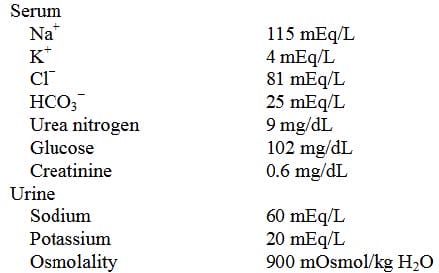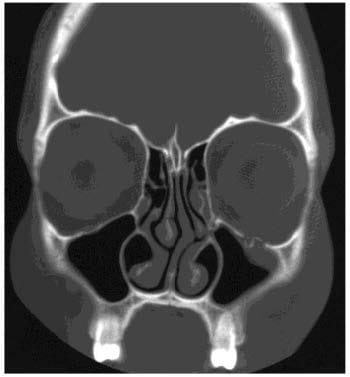Exam Details
Exam Code
:USMLEExam Name
:United States Medical Licensing ExaminationCertification
:USMLE CertificationsVendor
:USMLETotal Questions
:622 Q&AsLast Updated
:Apr 13, 2025
USMLE USMLE Certifications USMLE Questions & Answers
-
Question 481:
A 6-day-old breast-fed boy is brought to the emergency department by his mother because of poor weight gain and irritability since delivery, and a 2-hour history of vomiting. Physical examination shows jaundice and hepatomegaly. A reducing substance test result of the urine is positive, and a glucose oxidase test result is negative. The concentration of which of the following metabolites in liver is most likely increased in this patient?
A. Fructose 1, 6-bisphosphate
B. Galactose 1-phosphate
C. Glucose 1-phosphate
D. Glucose 6-phosphate
-
Question 482:
A 14-year-old boy is brought to the physician because of a 2-day history of a sore throat and fever that peaks in the late afternoon. He also has a 1-week history of progressive fatigue. He recently began having unprotected sexual intercourse with one partner. He appears ill. His temperature is 39°C (102.2°F). Physical examination shows cervical lymphadenopathy and pharyngeal erythema with a creamy exudate. Which of the following is the most likely diagnosis?
A. Candidiasis
B. Herpahgina
C. Infectious mononucleosis
D. Mumps
E. Syphilis
-
Question 483:
A randomized controlled trial is conducted to assess the risk for development of gastrointestinal adverse effects using azithromycin compared with erythromycin in the treatment of pertussis in children. Of the 100 children with pertussis enrolled 50 receive azithromycin, and 50 receive erythromycin. Results show vomiting among 5 patients in the azithromycin group, compared with 15 patients in the erythromycin group. Which of the following best represents the absolute risk reduction for vomiting among patients in the azithromycin group?
A. 0.1
B. 0.2
C. 0.33
D. 0.67
E. 0.8
-
Question 484:
A 35-year-old woman comes to the office because of a 3-day history of severe right back pain. She has not had any fever, chills, or weight loss. She has no history of major medical illness. Musculoskeletal and neurologic examinations show no abnormalities. When told that her examination is normal, the patient becomes tearful and demands an MRI of her back because her mother just died from breast cancer metastatic to bone and she fears that she may also have cancer. The patient already contacted her insurance company, who told her that if she has neurologic abnormalities an MRI may be covered by her plan. The patient asks the physician to order the MRI indicating that she has neurologic findings. Which of the following is the most appropriate initial action by the physician?
A. Advise the patient to change insurance companies as soon as she is able so that she can receive more comprehensive medical care
B. Explain that the patient does not need the MRI and that it is not appropriate to misrepresent her examination findings
C. Immediately inform the patient's insurance company about what the patient has asked the physician to do
D. Order the MRI as the patient requests
E. Recommend that the patient pay for the MRI out-of-pocket in order to ease her worry
-
Question 485:
A 67-year-old woman is brought to the emergency department 30 minutes after she had a generalized tonic-clonic seizure. Her family says that she seemed mildly confused before her eyes rolled backward and she had the onset of uncontrollable jerking movements of her arms and legs and loss of consciousness. During the seizure, she passed urine and bit her tongue. At the scene, her vital signs were within normal limits. She has a 6-month history of a 7-kg (15-lb) weight loss despite no changes in appetite. She received the diagnosis of small cell carcinoma of the lung last week and has not begun treatment. She has hypertension well controlled with lisinopril. On arrival, she is awake but does not respond to verbal stimuli. She is not in distress. Her temperature is 37°C (98.6°F), pulse is 70/min, and blood pressure is 130/88 mmHg while supine. Examination shows no abnormalities. Laboratory studies show:

Which of the following is the most likely diagnosis?
A. Adrenal insufficiency
B. Diuretic abuse
C. Heart failure
D. Syndrome of inappropriate secretion of ADH (vasopressin)
E. Water intoxication
-
Question 486:
A 23-year-old woman comes to the physician for genetic counseling prior to conception. Her brother and maternal uncle had Duchenne muscular dystrophy (DMD) and died at the ages of 28 and 17 years, respectively. Genetic analysis was not performed on either relative prior to death. Serum studies show a muscle creatine kinase concentration of 120 U/L (N = 22 – 198). The patient's 50-year-old mother has a serum muscle creatine kinase concentration of 300 U/L. Which of the following is the most appropriate assessment of this patient's carrier status for this disease?
A. The patient has a 50% risk for developing DMD
B. The patient has a 50% risk of having a child with DMD
C. The patient is a carrier of the disease based on her family history of DMD
D. The patient is not a carrier of the DMD based on her normal creatine kinase concentration
E. The patient's DMD carrier status is uncertain because of random X inactivation
-
Question 487:
During a study of renal glomeruli, a healthy animal kidney is kept in a vascular bath preparation at a constant afferent arterial pressure of 100 mmHg. If the efferent arteriole is constricted with a vascular clamp, which of the following Starling forces is most likely to change in the glomeruli?
A. Decreased filtration coefficient (Kf)
B. Decreased hydrostatic pressure
C. Decreased oncotic pressure
D. Increased hydrostatic pressure
E. Increased oncotic pressure
-
Question 488:

A 2-year-old boy is brought to the office by his mother because of a 1-day history of severe pain, swelling, and redness of his left thumb. The mother does not recall any trauma to the area. She says he has been eating poorly during this period, but otherwise he has been behaving normally. He has no history of major medical illness and receives no medications. He appears tearful. He is at the 90th percentile for length and 80th percentile for weight. His temperature is 37.7°C (99.8°F), pulse is 100/min, respirations are 20/min, and blood pressure is 100/50 mmHg. Physical examination shows an oral vesicle, cervical lymphadenopathy, and the findings in the photograph. Which of the following types of infectious agents is the most likely cause of the findings in this patient's finger?
A. DNA virus
B. Gram-negative bacterium
C. Gram-positive bacterium
D. RNA virus
E. Yeast
-
Question 489:
A 46-year-old woman with active ankylosing spondylitis comes to the office for a follow-up examination. The use of various conventional nonsteroidal anti-inflammatory drugs has been ineffective. Sulfasalazine treatment also has not resulted in improvement. The most appropriate next step in treatment is administration of a drug that inhibits which of the following?
A. CD20
B. Cyclooxygenase-2
C. Cytotoxic T-lymphocyte antigen 4
D. Epidermal growth factor
E. nterleukin-1 (IL-1)
F. Tumor necrosis factor α
-
Question 490:

A 42-year-old woman is brought to the emergency department because of double vision that began 20 minutes after she fell from her horse and landed on the left side of her face. Examination of the face shows ecchymoses over the left zygomatic arch. A CT scan of the head is shown. Which of the following arteries is at greatest risk for injury in this patient?
A. Facial
B. Frontal
C. Infraorbital
D. Lacrimal
E. Ophtmalmic
Tips on How to Prepare for the Exams
Nowadays, the certification exams become more and more important and required by more and more enterprises when applying for a job. But how to prepare for the exam effectively? How to prepare for the exam in a short time with less efforts? How to get a ideal result and how to find the most reliable resources? Here on Vcedump.com, you will find all the answers. Vcedump.com provide not only USMLE exam questions, answers and explanations but also complete assistance on your exam preparation and certification application. If you are confused on your USMLE exam preparations and USMLE certification application, do not hesitate to visit our Vcedump.com to find your solutions here.